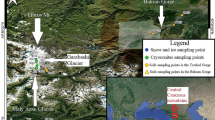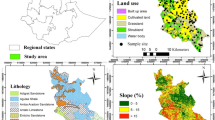Abstract
Small areas of steppe-like vegetation (steppoids) occur on southern slopes among open larch woodlands in the lower reaches of the Kolyma River, northeastern Siberia. Depending on the soil parent material, they are divided into petrophytic (on the bedrock colluvium) and thermophytic (on silty loam of the Yedoma (Ice Complex) formation) steppoids. Xeromorphic deeply thawing soils with diverse humus-accumulative horizons, high content of roots, fine subangular blocky structure, and an increased content of water-stable microaggregates are formed in steppoids. These soils from differ from the soils of surrounding taiga landscape by the decreased actual and potential acidity; higher contents of exchangeable bases, soluble salts, carbonates, and organic nitrogen; smaller ratio between concentrations of oxalate- and dithionite-extractable iron. The soils of steppoids, especially thermophytic steppoids, are zooturbated. Dark mull-like forms of humus on the surface of mineral grains are present among the microaccumulations of organic matter in these soils. The features of cryoxerozemic pedogenesis are better manifested in petrophytic steppoids. The soils of thermophytic steppoids have similar features with steppe cryoarid ones, but differ from the latter in the absence of carbonate-accumulative and cryohumus horizons and in a relatively high acidity. Among the soils of petrophytic steppoids, gray-humus lithozems and gray-humus or mucky–dark-humus soils with carbonate incrustation can be distinguished. The soils of thermophytic steppoids can be classified as gray-humus or mucky–dark-humus surface-turbated (zooturbated) soils.








Similar content being viewed by others
Notes
Hereinafter, data on 2006–2011 are presented, i.e., on the period, when the temperature regime of soils under steppoids was specially studied.
REFERENCES
E. V. Arinushkina, Manual on the Chemical Analyses of Soils (Mosk. Univ., Moscow, 1962) [in Russian].
D. I. Berman, “Tundra-steppes of Pleistocene Beringia and modern insects,” Priroda, No. 11, 22–33 (2001).
D. I. Berman and A. V. Alfimov, “Microclimatic conditions for the existence of steppe ecosystems in the Subarctic of northeast Asia,” Byull. Mosk. O-va. Ispyt. Prir., Otd. Biol. 98 (3), 118–128 (1993).
D. I. Berman and A. V. Alfimov, “Reconstruction of Late Pleistocene climates of Asian and central Beringia based on entomological data,” Vestn. Dal’nevost. Otd. Ross. Akad. Nauk, No. 1, 27–34 (1998).
D. I. Berman, A. V. Alfimov, G. G. Mazhitova, I. B. Grishkan, and B. A. Yurtsev, Cold Steppes of Northeast Asia (Inst. Biol. Probl. Sev. Dal’nevost. Otd. Ross. Akad. Nauk, Magadan, 2001) [in Russian].
M. A. Bronnikova, M. I. Gerasimova, Yu. V. Konoplianikova, E. A. Gurkova, G. I. Chernousenko, V. A. Golubtsov, and O. E. Efimov, “Cryoaridic soils as a genetic type in the Russian soil classification system: geography, morphology, diagnostics,” Eurasian Soil Sci. 55 (3), 283–298 (2022).
G. M. Bystryakov, Extended Abstract of Candidate’s Dissertation in Biology (Mosk. Univ., Moscow, 1979).
G. M. Bystryakov, “High-humus illuvial-metamorphic soils of Western Chukotka,” Pochvovedenie, No. 1, 5–17 (1988).
G. M. Bystryakov and E. V. Kulinskaya, “Soils of steppe cryoarid landscapes of the upper reaches of the Kolyma and Indigirka,” in Geography and Genesis of Soils in the Magadan Oblast (Vladivostok, 1980), pp. 143–160 [in Russian].
A. F. Vadyunina and Z. A. Korchagina, Methods for Studying the Physical Properties of Soils and Grounds (Vysshaya Shkola, Moscow, 1973) [in Russian].
A. P. Vas’kovskii, “Spore-pollen spectra of modern plant communities in the Far Northeast of the USSR and their significance for the restoration of Quaternary vegetation,” in Materials on Geology and Mineral Resources of the North-East of the USSR (Kn. Izd., Magadan, 1957), No. 11, pp. 130–178 [in Russian].
A. P. Vas’kovskii, “Geographical peculiarities of the soils in the forest region of the Far Northeast of the USSR,” in Notes on Local History (1960), Vol. 3, pp. 72–108.
V. I. Volkovintser, Steppe Cryoarid Soils (Nauka (Sib. Otd.), Novosibirsk, 1978) [in Russian].
Geological Map of the North-East of the USSR. Scale 1 : 1 500 000 (MinGeo of the RSFSR, Kamchatskoe PGO, Severo-Vostochnoe PGO, Yakutskoe Proizvodstvennoe Geologicheskoe Ob’edinenie (Yakutskgeologia), 1980).
I. P. Gerasimov, “Uniqueness of genetic types of soils in Siberia,” in Siberian Geographical Collection (Izd. Akad. Nauk SSSR, Moscow, 1963), No. 2, pp. 7–27.
O. V. Grinenko, Yu. B. Gladenkov, and L. Yu. Budantsev, Paleogene and Neogene of the North-East of the USSR (Yakutsk, 1989) [in Russian].
S. V. Gubin, Extended Abstract of Doctoral Dissertation in Biology (Pushchino, 1999).
V. N. Dimo, Thermal Conditions of Soils in the USSR (Kolos, Moscow, 1972) [in Russian].
T. M. Zaslavskaya and V. V. Petrovskii, “Flora of vascular plants in the vicinity of the Cherskii village (Northern Yakutia),” Bot. Zh. 79 (2), 65–79 (1994).
V. G. Zol’nikov, “Soils of the eastern half of Central Yakutia and their use,” in Materials on Natural Conditions and Agriculture of Central Yakutia (Izd. Akad. Nauk SSSR, Yakutsk, 1954), Vol. 1, pp. 55–221 [in Russian].
S. V. Zonn, Iron in Soils (Genetic and Geographical Aspects) (Nauka, Moscow, 1982) [in Russian].
E. N. Ivanova, N. N. Rozov, A. A. Erokhina, N. A. Nogina, V. A. Nosin, and K. A. Ufimtseva, “New materials on the general geography and classification of soils in the polar and boreal zones of Siberia,” Pochvovedenie, No. 11, 7–23 (1961).
Classification and Diagnosis of Russian Soils (Oikumena, Smolensk, 2004) [in Russian].
Yu. P. Kozhevnikov, “Critical review of data concerning the problem of florogenesis in Chukotka,” Bot. Zh. 62 (3), 445–460 (1977).
Yu. P. Kozhevnikov, “Botanical and ecological observations in the Kolyma in the areas of the middle reaches of the Berezovka section and Cherskii village,” in Biology and Ecology of Plants in the Kolyma Basin (Dal’nevost. Nauchn. Tsentr Akad. Nauk SSSR, Vladivostok, 1981), pp. 99–117 [in Russian].
L. T. Kozitskaya and V. Yu. Razzhivin, “Relict xerophytic communities in the west of the Chukotka Peninsula and their soils,” Ekologiya, No. 3, 32–38 (1985).
E. M. Lavrenko, “History of flora and vegetation of the USSR according to modern plant distribution data,” in Vegetation of the USSR (Izd. Akad. Nauk SSSR, Moscow-Leningrad, 1938), Vol. 1, pp. 235–296.
E. M. Lavrenko, Z. V. Karamysheva, and R. I. Nikulicheva, Steppes of Eurasia (Nauka, Leningrad, 1991) [in Russian].
G. G. Mazhitova, “Soil cover of Sibit-Tyellah basin,” in Belt of Open Forests of the Upper Kolyma (Vladivostok, 1985), pp. 30–43.
O. V. Makeev and V. E. Ostroumov, “Temperature field and annual heat turnover in soils,” in Advances in Soil Science: Soviet Soil Scientists for the 13th International Congress of Soil Scientists, Hamburg, Ed. by V. A. Kovda and M. A. Glazovskaya (Nauka, Moscow, 1986), pp. 27–32.
S. V. Maksimovich, “Ecology of steppe soils and vegetation in the Far Northeast of Yakutia (tundra and forest-tundra zone),” Kriosfera Zemli 2 (2), 26–32 (1998).
E. M. Naumov, “Cryoarid soils of the North Pole of Cold,” in Permafrost and Soils. Reports of the All-Union Conference on Permafrost Soils (Yakutsk, 1974), Vol. 3, pp. 104–110.
E. M. Naumov, Doctoral Dissertation in Agriculture (Pochv. Inst. im. V. V. Dokuchaeva, Moscow, 1993).
E. M. Naumov and N. A. Andreeva, “Soils of the steppe slopes of the Yana-Indigirka Plateau (taiga-steppe soils of the extracontinental oblasts of the North-East of the USSR),” Pochvovedenie, No. 3, 62–70 (1963).
D. S. Orlov, Soil Chemistry (Mosk. Univ., Moscow, 1992) [in Russian].
D. S. Orlov and L. A. Grishina, Workshop on Humus Chemistry (Mosk. Univ., Moscow, 1981) [in Russian].
K. E. Pustovoitov, Extended Abstract of Candidate’s Dissertation in Biology (Mosk. Univ., Moscow, 1993).
T. A. Rabotnov, “In the steppes of Central Yakutia,” Priroda, No. 2, 65–66 (1945).
S. Z. Skryabin and A. K. Konorovskii, “Vegetation and soils of the steppes of the middle reaches of the Indigirka,” in Botanical Materials for Yakutia (Yakutsk, 1975), pp. 38–47 [in Russian].
I. A. Sokolov, G. M. Bystryakov, and E. V. Kulinskaya, “On the characteristics of ultracontinental cold arid soil formation,” in Specifics of Soil Formation in Siberia (Nauka (Sib. Otd.), Novosibirsk, 1979), pp. 9–13 [in Russian].
V. B. Sochava and V. V. Lipatova, “Groups of steppe plants in the Amur subtaiga,” in Proceedings of the Moscow Society of Natural Scientists. Collection of Works on Geobotany, Botanical Geography, Plant Taxonomy and Paleogeography (Mosk. O-vo. Ispyt. Prir., Moscow, 1960), pp. 263–276.
D. G. Fedorov-Davydov, S. P. Davydov, A. I. Davydova, V. E. Ostroumov, A. L. Kholodov, V. A. Sorokovikov, and D. G. Shmelev, “Temperature regime of soils in Northern Yakutia,” Kriosfera Zemli, No. 4, 15–24 (2018).
D. A. Chernyakhovskii, “Ecological-genetic analysis of tundra-steppe soils of North-East Siberia,” Pochvovedenie, No. 5, 541–550 (1995).
V. A. Sheludyakova, “Vegetation of the Indigirka River basin,” Sov. Bot., Nos. 4–5, 43–79 (1938).
V. A. Sheludyakova, Vegetation of the Verkhoyansk region of the Yakutian ASSR (Botanical and Geographical Outline) (Yakutsk. Gos. Izd., Yakutsk, 1948) [in Russian].
V. A. Sheludyakova, “Steppe vegetation of the Yakutian polar region,” in Proceedings of the Institute of Biology of the Yakutsk Branch of the Academy of Sciences of the USSR (Yakutsk, 1957), Vol. 3, pp. 68–82.
A. V. Sher, T. N. Kaplina, R. E. Giterman, A. V. Lozhkin, A. A. Arkhangelov, E. I. Virina, V. S. Zazhigin, S. V. Kiselev, and Yu. V. Kuznetsov, Late Cenozoic Deposits of the Kolyma Lowland. Guide to the Scientific Excursion of the 14th Pacific Scientific Congress. Round 11 (Tikhookeanskaya Nauchnaya Assotsiatsiya, Moscow, 1979) [in Russian].
D. G. Shmelev, V. V. Rogov, S. V. Gubin, and S. P. Davydov, “Cryolithogenic deposits on the right bank of the lower reaches of the Kolyma River,” Vestn. Mosk. Univ., Ser. 5: Geogr., No. 3, 66–72 (2013).
B. A. Yurtsev, Problems of Botanical Geography of Northeast Asia (Nauka, Leningrad, 1974) [in Russian].
B. A. Yurtsev, “Some questions of the typology of steppe communities in Northeast Asia,” Bot. Zh. 63 (11), 1566–1578 (1978).
B. A. Yurtsev, Relict Steppe Complexes of Northeast Asia (Problems of Reconstruction of Cryoxerotic Landscapes of Beringia) (Nauka, Novosibirsk, 1981) [in Russian].
M. I. Yarovoi, “Vegetation of the Yana River basin and the Verkhoyansk Range,” Sov. Bot., No. 1, 21–40 (1939).
H. A. Binney, M. E. Edwards, M. Macias-Fauria, A. V. Lozhkin, P. M. Anderson, J. O. Kaplan, E. Bezrukova, et al., “Vegetation of Eurasia from the last glacial maximum to present: key biogeographic patterns,” Quat. Sci. Rev. 157, 80–97 (2017).
M. S. Blinnikov, B. V. Gaglioti, D. A. Walker, M. J. Wooller, and G. D. Zazula, “Pleistocene graminoid-dominated ecosystems in the arctic,” Quat. Sci. Rev. 30, 2906–2929 (2011).
S. Davydov, A. Davydova, M. Schelchkova, R. Makarevich, D. Fyodorov-Davydov, M. Loranty, and G. Boeskorov, “Essential mineral nutrients of the high-latitude steppe vegetation and the herbivores of mammoth fauna,” Quat. Sci. Rev. 228, N106073 (2020).
J. K. Heslop, S. Chandra, W. V. Sobzcak, S. P. Davydov, A. I. Davydova, V. V. Spektor, and K. M. Walter Anthony, “Variable respiration rates of incubated permafrost soil extracts from the Kolyma River lowlands, north-east Siberia,” Polar Res. 36, 1751–8369 (2017).
Funding
This work was supported by state assignments of the Institute of Physicochemical and Biological Problems of Soil Science, Russian Academy of Sciences, no. 122040500038-3, the Pacific Geographical Institute, Far East Branch, Russian Academy of Sciences, no. 122020900184-5, and the Institute of Geology of Diamond and Precious Metals (FUEM-2019-0002 no. AAAA-A17-117021310217-0), Siberian Branch of the Russian Academy of Science. In part, it was supported by the Russian Foundation for Basic Research, project no. 07-05-00313-a.
Author information
Authors and Affiliations
Corresponding author
Ethics declarations
CONFLICT OF INTEREST
The authors declare of this work that they have no conflicts of interest.
ETHICS APPROVAL AND CONSENT TO PARTICIPATE
This work does not contain any studies involving human and animal subjects.
Additional information
Translated by D. Konyushkov
Publisher’s Note.
Pleiades Publishing remains neutral with regard to jurisdictional claims in published maps and institutional affiliations.
Supplementary Information
Table S1 . Description of soil profiles.
Fig. S2 . Vegetation of petrophytic and thermophytic steppoids.
Table S3 . Group and fractional composition of humus in the soils of steppoids, % of Corg.
Rights and permissions
About this article
Cite this article
Fedorov-Davydov, D.G., Davydov, S.P., Gubin, S.V. et al. Soils of Steppe Areas in the Cis-Tundra Open Woodland Subzone on the Right Bank of the Kolyma River in Its Lower Reaches. Eurasian Soil Sc. 57, 762–779 (2024). https://doi.org/10.1134/S1064229324600027
Received:
Revised:
Accepted:
Published:
Issue Date:
DOI: https://doi.org/10.1134/S1064229324600027




